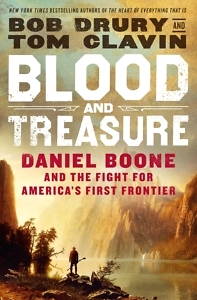Interloper, Hunter, Settler
Blood and Treasure chronicles Daniel Boone’s role in settling Kentucky
In May 1769, Daniel Boone and a small party of hunters skirted the base of Cumberland Mountain in Virginia’s southwestern corner, following an ancient buffalo trail known to the trans-Appalachian tribes as Athiamiowee, or the Warrior’s Path. Near the south end of the mountain, the wide path led up a gentle slope to a notch in the ridge: the Cumberland Gap. Beyond lay the land of “Kanta-ke,” Iroquois for “place of lush meadows.”

Boone didn’t discover the gap, but what he carried over the mountain that day, write Bob Drury and Tom Clavin in Blood and Treasure: Daniel Boone and the Fight for America’s First Frontier, was a “vision which paralleled … American expectations regarding western settlement.”
The region of Kanta-ke that Boone would explore and settle was part buffer state and part intertribal park. Its borders, according to Drury and Clavin, were the Ohio River to the north and the Cumberland River to the south. The Shawnee, based north of the Ohio, and the Cherokee from the Great Smoky Mountains, could hunt in the region without fear of belligerence. Other tribes — Wyandot, Mingo/Iroquois, and Chickasaw, among others — used the land, as well.
The Cumberland Gap transformed Boone and other woodsmen of his day into “long hunters,” men who spent months in the wilderness, hoping to return East with pack horses stacked with valuable pelts bound for European markets. The indigenous tribes treated the hunters as interlopers. Seven months after Boone initially crossed the Gap, a Shawnee band accosted him and his hunting partner, first confiscating their furs and later — when Boone ignored their demands to depart — taking them prisoner before letting them escape and return to the colonies.

Boone left his own mark on the Warriors’ Path, slashing signs into trees leading up to the pass. Many would follow the path westward. “Thus did an obscure former farmer and long hunter from the outskirts of what was then considered civilization … etch his name into the annals of American history,” Drury and Clavin write. “The ‘Boone Trace,’ as the trail was first labeled, was destined to be trod over the coming decades by some three hundred thousand immigrants who came to know it as the ‘Wilderness Road.’”
In 1775, North Carolina lawyer Richard Henderson exchanged three wagonloads of firearms, clothing, and other merchandise with the Cherokee for the whole of Kanta-ke, 18 million acres, hoping to create a state he would call “Transylvania.” That the area was still claimed by Shawnee — not to mention the Virginia Colony — was of little concern. Henderson needed settlers. He turned to Boone, whose previous attempt to settle Kentucky had been aborted after the brutal murder of his eldest son, James. Thus, the interlopers became squatters.
 As Boone and his migrant caravan crossed the Cumberland Gap and moved northward toward the Kentucky River, the Revolutionary War flared to life in faraway Massachusetts. Ultimately, few places in the American colonies would see fighting as fierce as the tiny settlement they named Boonesborough. The Shawnee, led by Chief Blackfish, wanted to reclaim Kanta-ke and found a timely ally in King George III. As British fortunes waned in the northern colonies, Britain sought — through indigenous recruits — to open a western front and defend crown lands between the Appalachians and the Mississippi River. Boone’s band, and a handful of other Kentucky settlements, held out.
As Boone and his migrant caravan crossed the Cumberland Gap and moved northward toward the Kentucky River, the Revolutionary War flared to life in faraway Massachusetts. Ultimately, few places in the American colonies would see fighting as fierce as the tiny settlement they named Boonesborough. The Shawnee, led by Chief Blackfish, wanted to reclaim Kanta-ke and found a timely ally in King George III. As British fortunes waned in the northern colonies, Britain sought — through indigenous recruits — to open a western front and defend crown lands between the Appalachians and the Mississippi River. Boone’s band, and a handful of other Kentucky settlements, held out.
Looking back on his life with his biographer, Boone remarked on the “blood and treasure” spent to secure Kentucky for American settlement. He lost two sons to Indian attacks. His family fled Boonesborough after his 1778 kidnapping by the Shawnee, and his wife’s family “did not bother to hide their loyalist feelings.”
Throughout Blood and Treasure, Drury and Clavin intersperse the events of Boone’s life with big-picture perspectives. The book opens a gap of sorts in a complex chain of colonial treaties, tribes, wars, and land-grabs, leading the reader to an appreciation of the many combatants in the conflict over Kentucky’s “dark and bloody ground.” Drury and Clavin illustrate the blood and treasure that was both won and lost as Boone, then long hunters, and finally migrants poured through the Cumberland Gap and appropriated the land known as Kanta-ke from its native claimants.

James Dittes teaches high school writing and German near Gallatin. In his free time, he enjoys hiking. The Cumberland Gap is among his favorite parks to explore.


